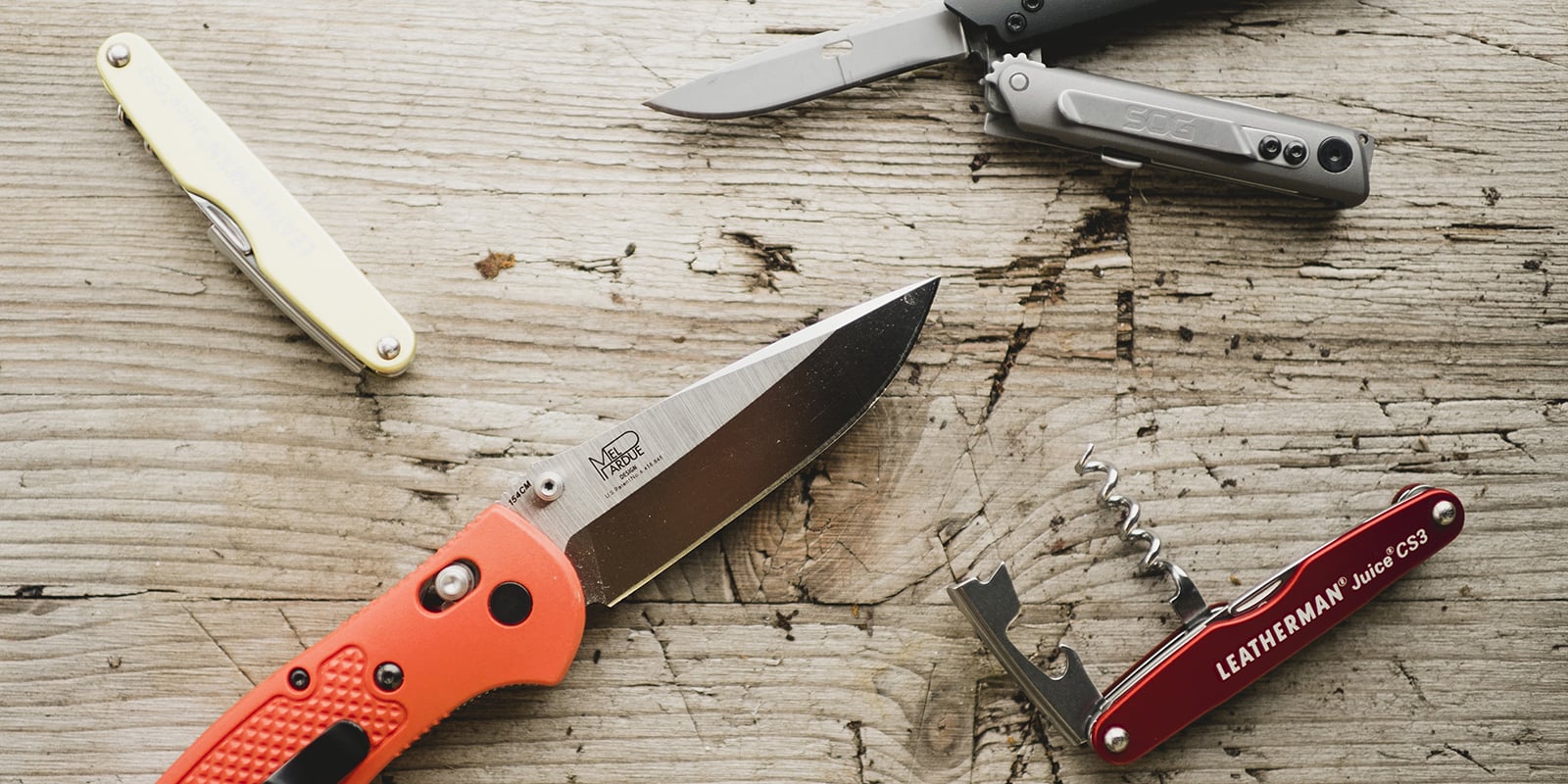One of the most useful items to keep in your pack, a sturdy knife or multi-tool will help you prepare food, cut cord, make repairs, fashion a roasting stick—or even save your life in an emergency.
Knives and multi-tools come in a wide variety of styles, designs and materials. The knife or tool you choose will be based on your intended use and activities. The best option for ultralight backpacking may differ from what you need for car camping or everyday use.
Types of Knives
Knives range from no-nonsense, fixed blades to compact pocket knives, and specialized knives for scenarios such as water rescue or woodcarving. Since no one knife will suit every task, some people carry multiple knives. However, with some careful consideration you can select a single knife that will handle most of your needs.
Pocket Knives
With folding blades, pocket knives don't take up much space and are ideal for hiking, backpacking and everyday tasks. They also keep the sharp edge protected inside the handle when not in use. However, smaller folding knives tend to lack the ergonomics and stability of fixed-blade knives, and a non-locking blade may accidentally fold down on your fingers while in use.
Fixed-Blade Knives
Fixed blades offer more strength, heft and ergonomic comfort than folding knives. They are easier to clean, but also weigh more, take up more space and require a sheath to carry safely.
Knife Features
Locking Blade
A locking blade combines the stability of a fixed-blade knife and the convenience of a folding knife. The blade folds down for compact, protected carrying, but locks into place when you open it to keep the blade from accidentally folding down while in use.
One-Handed Opening
Some folding blades are designed to open quickly with one hand. A smooth folding mechanism and a stud, notch or cutout on the blade make it easy to push the knife open with your thumb. An ambidextrous knife can be opened easily with either hand.
Shop One-Handed Opening Knives
Assisted Opening
When you start to open the blade, an assisted-opening mechanism engages and fully opens the knife. Assisted-opening knives feature a safety lock that disengages the mechanism when the knife is closed to prevent the blade from opening accidentally.
Knife Blade Shapes
There are many types of knife blades; here are a few of the more common ones you'll find for camping and outdoor use:
Strong and versatile, a drop-point blade has a thick point that is perfect for a wide variety of heavy tasks and general knife work. The blade's spine drops toward the tip, creating a shape that reduces accidental puncturing.
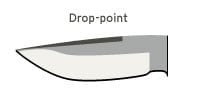
A clip-point blade features a crescent drop on the top of the blade that creates a thin, sharp point. Clip-point blades are ideal for puncturing and offer enhanced control for exacting, detailed work, but lack the strength of broader drop-point blades.
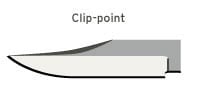
A heavy-duty tanto blade features an angular tip and a strong point that offers extra strength for prying, scraping and piercing tough materials.
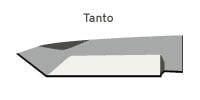
Needle-point and spear-point blades typically feature double edges and symmetrical points. Ideal for survival situations, they are designed primarily for puncturing and throwing.
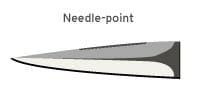
Sheepsfoot and Santuko blades are great for food preparation. They feature a spine that rounds off steeply to the point and the cutting edge is straight from the handle to the point, rather than curved. This shape makes it easy to cut, chop and slice while minimizing the risk of accidentally piercing with the point.
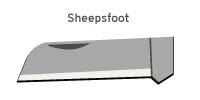
Knife Blade Materials
Ideally, a knife blade should resist corrosion, retain a sharp edge through sustained use and sharpen easily. However, there are trade-offs to consider: Harder steel holds a better edge and is less resistant to rust, but is also more difficult to sharpen. Softer steel may have higher corrosion resistance and is easier to sharpen, but usually doesn't hold an edge as well.
Stainless Steel
Most blades are made of stainless steel, an alloy that resists rust and corrosion. Three popular examples of stainless steel used for knife blades include:
420HC: This affordable stainless steel resists corrosion, sharpens easily and features fair edge retention.
154CM: Higher-grade stainless steel contains a higher amount of carbon for more hardness and good edge retention.
S30V: Premium stainless steel contains a high amount of vanadium (a rust-resistant carbide that adds wear-resistance and toughness to a blade) for superior edge retention.
High-Carbon Steel
Some knives are made with non-stainless high-carbon steel. These blades feature outstanding hardness and edge retention, but are much more vulnerable to corrosion than stainless-steel blades.
Knife Handle Materials
Often textured for improved grip and shaped for ergonomic comfort, knife handles are made of a wide variety of materials to suit your intended environment, aesthetic tastes and preferences for feel.
Wood handles are beautiful and provide good grip, but are susceptible to water damage.
Plastic handles are affordable and resist water damage, but can be slippery.
Rubber handles offer great grip and water resistance, but can lack durability.
Stainless-steel and aluminum handles are durable, but can feel cold and slippery in your hand.
Multi-Tools
Like a tiny toolbox in the palm of your hand, a compact and versatile multi-tool performs many more tasks than a traditional pocket knife. While their smaller size and reduced ergonomics make them less powerful than full-size tools, multi-tools are more than capable of handling many of the small repairs and projects you encounter in outdoor adventures and daily life.
Some multi-tools offer an activity-specific selection of implements, such as tools for cycling. Make a mental list of the situations you anticipate, and shop for a multi-tool that contains the appropriate size, quality and implements to meet your needs.
Implements
Multi-tools are typically built around folding pliers as the centerpiece of their functional design. Common implements include one or more blades, standard and Phillips screwdrivers, scissors, wire cutter, saw, file, bottle opener and can opener. Other implements often found on multi-tools include a corkscrew, tweezers, toothpick, wire stripper, ruler and awl.
Size
Multi-tools range in size from minimalist, ultralight designs with just the bare essentials to burly, rugged workhorses with full-size pliers.
Small, keychain-friendly multi-tools can be carried virtually anywhere, but lack the strength and versatility of their larger siblings. Slip one in your pocket when you go hiking or on your commute and forget it's there until you need it.
Pocket multi-tools combine manageable size with a decent array of implements. They fit nicely in a pants pocket, but have lighter-duty construction and are less ergonomic than larger models. Lighter and more compact than full-size models, these medium-size multi-tools are ideal for backpacking or other activities where size and weight matter.
Built to handle heavy-duty tasks, the largest multi-tools provide more torque, durability and ergonomic comfort. Perfect for car camping, they weigh more and take up more space than smaller multi-tools, and often come with a sheath for wearing on your belt.
Camp Tools
Sometimes when you're enjoying the outdoors, a knife or multi-tool won't handle all your tasks. Here are a few more camp tools you may find useful.
Axes and hatchets are great for splitting kindling and pounding tent stakes.
A lightweight folding saw makes it easy to cut firewood down to size.
Ranging in size from small handheld trowels to larger folding models, a shovel comes in handy for digging a cat hole when nature calls or smoothing out the ground at a rocky tent site.
A sturdy machete is a champ at clearing brush and for light chopping tasks.
